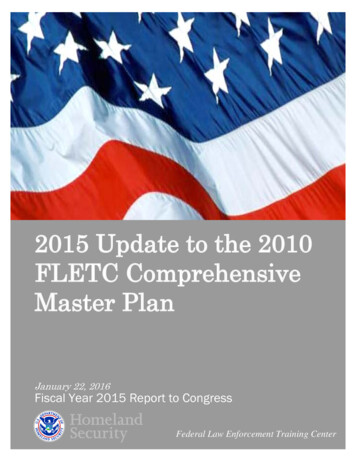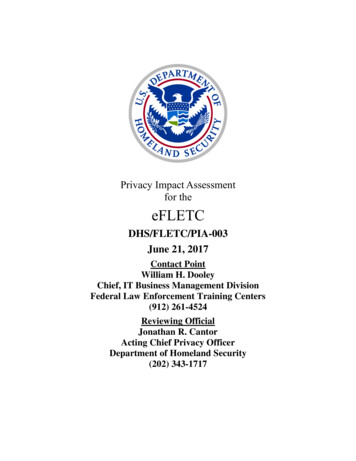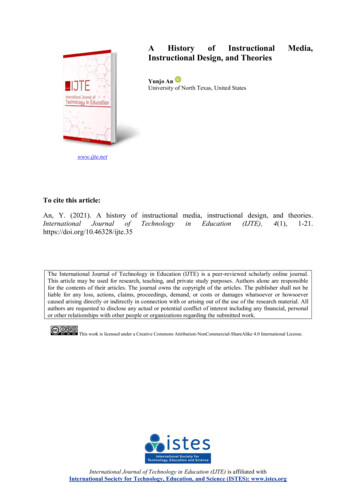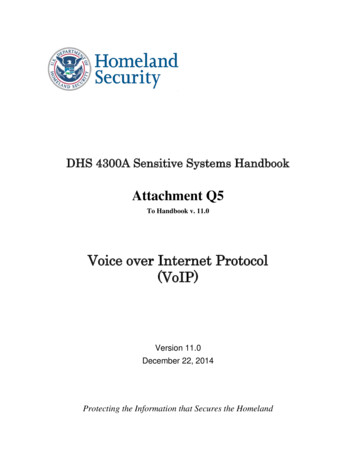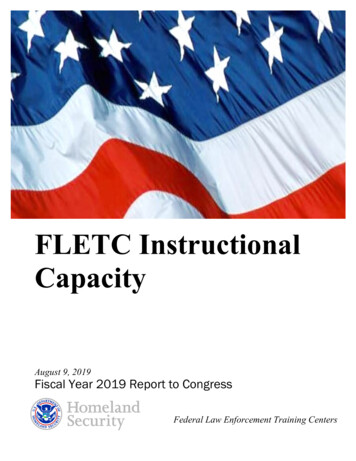
Transcription
FLETC InstructionalCapacityAugust 9, 2019Fiscal Year 2019 Report to CongressFederal Law Enforcement Training Centers
Message from the DirectorAugust 9, 2019I am pleased to present the following report, "Federal LawEnforcement Training Centers Instructional Capacity," which hasbeen prepared by the Federal Law Enforcement Training Centers(FLETC).This document has been compiled pursuant to language in SenateRep01i 115-283, which accompanies the Fiscal Year (FY) 2019Department of Homeland Security Appropriations Act(P.L. 116-6).Pursuant to congressional requirements, this report is beingprovided to the following Members of Congress:The Honorable Lucille Roybal-AllardChairwoman, House Appropriations Subcommittee on Homeland SecurityThe Honorable Chuck FleischmannRanking Member, House Appropriations Subcommittee on Homeland SecurityThe Honorable Shelley Moore CapitoChahman, Senate Appropriations Subcommittee on Homeland SecurityThe Honorable Jon TesterRanking Member, Senate Appropriations Subcommittee on Homeland SecurityInquiries regarding this report may be directed to me at (912) 267-2070.DirectorFederal Law Enforcement Training Centers1
Executive SummarySenate Report 115-283 articulates Congress’s expectation that FLETC maintain training at ornear facility capacity before entering into new leases or establishing new partnerships withtraining organizations. Accordingly, Senate Report 115-283 directs FLETC to provide a costanalysis detailing FLETC’s capacity at each site as measured against annual student occupancy.As a technical school for law enforcement professionals for more than 90 federal lawenforcement agencies, FLETC is unlike any other training institution. In addition to providingservice to such a large number of agencies, FLETC also is able to accommodate constantlyevolving training schedules that require nearly countless combinations of hundreds of distincttraining venues with varying arrival timeframes and program lengths, thus enabling theseagencies to meet their operational mission. This unique character informs the relationshipbetween FLETC’s maximum capacity, the courses it delivers, and FLETC’s annual studentoccupancy rate. With the backdrop of these factors, FLETC has developed a model forcalculating its instructional capacity and showing training throughput as a proportion of thatcapacity.This report represents the model that FLETC has developed to calculate instructional capacity.FLETC defined a baseline mathematical construct that accounts for the supply of availablefacilities. From that, FLETC derived an operational baseline that accounts for the trainingdemands of FLETC’s more than 90 federal participating organizations, which instigate complexschedules that are revised continuously to meet the requirements of FLETC’s clients/partners.FLETC then utilized the mathematical and operational baselines to identify instructional capacityat each site. FLETC determined its current enterprisewide instructional capacity to be 231,803student weeks across 4 sites, with utilization as a proportion of that capacity in FY 2018 at 90.94percent.The model described in this report assists FLETC in identifying training venue chokepoints inorder to ascertain future requirements, and provides a realistic indicator of how much trainingFLETC can accommodate without taking extraordinary measures. FLETC is committed tocontinued analysis of its instructional capacity in order to remain a good steward of the fundingthat Congress appropriates to it, and to ensure that it provides the training that federal lawenforcement officers and agents need to be effective in their operating environments.ii
FLETC Instructional CapacityTable of ContentsI.Legislative Language .1II.Background .2III.Results.3Development of Baseline Mathematical Construct .3Development of Operational Baselines .4Development of Instructional Capacity .5IV. Analysis/Discussion .6V.Conclusion .8Appendix: Abbreviations .9iii
I.Legislative LanguageSenate Report 115-283, which accompanies the Fiscal Year (FY) 2019 Department of HomelandSecurity (DHS) Appropriations Act (P.L. 116-6), includes the following requirement:Funding above the fiscal year 2018 enacted level is provided to meet a projectedincrease in basic training requirements. The Committee expects FLETC to maintaintraining at or near facility capacity before entering into new leases or establishingnew partnerships with training organizations. To that end, the Committee directsFLETC to provide a cost analysis detailing, at minimum, each training center’smaximum instructional capacity by course and measured against its annual studentoccupancy.1
II. BackgroundThe Federal Law Enforcement Training Centers (FLETC) is unlike any other training institution.It is a technical school for federal law enforcement professionals from more than 90 federal lawenforcement agencies. This unique training mission, and its associated distinctive administrativeand logistics infrastructure, reflect its one-of-a-kind character. This unique character informs therelationship between FLETC’s maximum instructional capacity, the courses it delivers, andFLETC’s annual student occupancy rate.Each training day, FLETC’s four training delivery points deliver, assist in delivering, or host acombination of training sessions that are unique to that day; that is, that combination of trainingsessions may never have occurred in the past, and may never be repeated in the future. FLETCand its participating organizations currently deliver 827 distinct training programs, which coulduse hundreds of thousands of combinations of nearly 1,100 different training facilities across 4training delivery points. Training program lengths range from 2 hours to 117 days. FLETC’straining workload varies each year, depending on the programs that its participatingorganizations require.FLETC’s ability to organize training sessions to respond to the constantly changing needs of itsmore than 90 federal participating organizations is an essential element of its value to its clients.Surges in hiring, changes in agency priorities, changes in agency budgets, and the dynamics ofrecruiting and hiring all affect agency training plans. Estimating FLETC’s annual capacity,therefore, is not as simple as outlining training to be delivered in light of available venuesbecause the programmatic mix and associated schedules change from year to year as FLETCaccommodates the dynamic training requirements of its clients. FLETC has developed strategiesto address contingencies as they arise. Unlike a traditional university, college, or technicalschool, which publishes a fixed schedule up to a year in advance, FLETC publishes a “living”schedule that is changing constantly because of evolving and/or unforeseeable participatingorganization needs.With the backdrop of these unique factors, FLETC has developed a model for calculating itsinstructional capacity and showing training throughput as a proportion of that capacity.2
III. ResultsFLETC identified its instructional capacity and FY 2018 capacity utilization 1 rates as aproportion of capacity for each of its 4 training delivery points as shown in Table 1:Table 1. Site CapacitySiteArtesia, New MexicoCharleston, South CarolinaCheltenham, MarylandGlynco, GeorgiaTotalInstructionalCapacity inStudent Weeks48,47924,66116,693141,970231,803FY 2018 0Utilization asProportion 94%FLETC developed Table 1 using the following methodology:Development of Baseline Mathematical ConstructAs its first step in calculating capacity, FLETC developed simulations for each training deliverypoint based on analysis of historical usage of facility type 2 at each site that would allow formaximum use of available venues. This capacity calculation resulted in two distinct models:one that applies to Glynco and Artesia and one that applies to Charleston and Cheltenham. Themodels differ because the types of programs that FLETC and its participating organizationsconduct at these sites differ. For Glynco and Artesia, the model is based on basic trainingprograms that utilize multiple venues at those sites. For Charleston and Cheltenham, which arehost to minimal basic training, the statistical model is based on usage of venues for the programsoccurring at those sites. In other words, the models for each site consist of a programmatic mixthat best represents the workload at each site and maximizes use of remaining “white space.” 3Using Glynco as an example, FLETC identified the basic training programs that constitute themajority of training at that site. FLETC then calculated how many of those programs it couldrun before reaching a chokepoint, which for Glynco is 48-person classrooms. FLETC populatedthe remainder of the model with advanced training programs that would fill all remaining1Capacity utilization in this analysis accounts for students who were in training during FY 2018 and unrealizeddemand (unfilled seats). In contrast, FLETC’s published training statistics only account for students who graduatedin FY 2018.2Because FLETC has 1,089 distinct training facilities, for purposes of developing these models, FLETC groupedfacilities into 10 categories as follows: 24-Person Classrooms, 48-Person Classrooms, Classrooms of “Other” Size,Breakout Rooms, Driving Ranges, Firearms Ranges, Firearms Classrooms, Mat Rooms, Mission-Specific Venues,and Tactical Venues.3For purposes of this analysis, FLETC assumed a training schedule of 7:30 a.m. to 4:30 p.m. Monday throughFriday, minus federal holidays and any other designated nontraining days.3
available space. FLETC then ran a Monte Carlo simulation to develop a figure representing totalstudent weeks and total students associated with that model as a baseline. This baselinerepresents a mathematical construct in which participating organization needs would alignprecisely with FLETC’s ability to meet those needs.It is critical to emphasize that this baseline represents a student-weeks figure that would requireFLETC to have a constant number of students at the mathematical maximum. However, thiscircumstance is not a practical representation of reality because FLETC’s training schedule iscompletely dependent upon demand from participating organizations. It would be highlyimprobable, if not impossible, to create a scenario in which demand matched the mathematicalmaximum every single day in a fiscal year.Development of Operational BaselinesUsing the mathematical baseline for each training delivery point as a starting point, FLETC thendeveloped operational baselines for each training delivery point that take into account demandfor FLETC training and associated execution. To develop these operational baselines, FLETCidentified the average student population (ASP) at each site for FY 2018. Using the highestmonthly ASP for each site because it represents the highest demand FLETC had that year at aparticular site, FLETC developed a weighting factor that it could apply to the Monte Carlosimulation. The operational baseline represents a student-weeks figure that shows how muchtraining FLETC could do at each site as described in the process above. By utilizing thisapproach, FLETC creates an operational baseline that considers real-world operational issues anduncertainties.The models account for the reality and complexity of scheduling that FLETC faces, which makesit virtually impossible for FLETC to fill all “white space.” Because the mixture of programsFLETC delivers each year is entirely on the basis of demand, and because those combinationschange each year on the basis of needs, FLETC’s scheduling personnel constantly work to fit inas much training as possible based on available venues. This occurrence inevitably means thatthere will be “white space,” but FLETC cannot fill that “white space” unless a required programfits perfectly into it.The nature of the training that FLETC conducts dictates that there always will be venues not inuse at particular times. For example, Program A may require firearms ranges on Monday, butnot on Tuesday of a given week. However, that does not mean necessarily that FLETC couldutilize those firearms ranges on Tuesday unless it could determine that another program runningcould use them on that specific day. In this way, it is inevitable that FLETC will have “whitespace” among its training venues, because demand for facilities is a function of which trainingprograms participating organizations require and when. Other reasons for “white space” includetraining workload that is distributed unevenly throughout the year because of budget processes,inherent inefficiencies emerging based on program sequencing necessary to maintain trainingquality, and the creation of ad hoc adjustments based on various conditions ranging from clients’ability to hire to adverse weather conditions. FLETC leverages its automated scheduling tool tofit in as much training as it can, in a manner that maximizes utilization of available facilities andalters course sequencing when at all possible without degrading quality of training. However,4
there inevitably will be days when particular venues are not in use because the particularprogrammatic mix that day does not require them.Using Glynco as an example, the first chokepoint is again 48-person classrooms. However, theoperational baseline accounts for the fact that even though a firearms range may be empty at thepoint that Glynco reaches maximum usage of its primary constraint, FLETC could not fill thatspace with more basic training necessarily. FLETC has to account for the venue requirementsassociated with the programmatic mix. The programmatic mix is developed entirely on the basisof demand.The operational baselines for each site represent FLETC’s calculation of how much training itcould do based on myriad factors. Note, since this calculation is weighted on demand in FY2018, these numbers are only effective for FY 2018.Development of Instructional CapacityHaving developed mathematical and operational baselines, the final step was for FLETC totranslate these figures to instructional capacity. The last piece to consider was how to accountfor programs that are not filled to maximum student capacity. For example, while a particularprogram is scheduled to hold 48 students, fewer students may arrive for the start of class.Additionally, some students will not graduate at the end. FLETC makes the business decision torun a program with, for example, 42 out of the maximum 48 students, because it is critical toensure that FLETC’s federal participating organizations can deliver new law enforcementpersonnel to the field. The qualitative benefit or public good of training new law enforcementpersonnel so that they can perform their agencies’ missions outweighs the inefficiency ofrunning a class at less than capacity. However, those six empty seats leave capacity that it isimpossible for FLETC to fill. These unfilled seats must be accounted for when calculatinginstructional capacity and capacity utilization as a proportion of it. In other words, the venues inuse for the unfilled program(s) are themselves 100 percent in use even though fewer students arein the venue than expected. For example, FLETC cannot use the empty spaces left on the firingrange or the empty seats in the classroom for other students who are enrolled in an entirelydifferent program.By weighting the original Monte Carlo-derived mathematical construct, FLETC developedinstructional capacities for each site as represented in Table 1. FLETC then added in theunrealized demand (unfilled seats) to represent FY 2018 capacity utilization as compared to theinstructional capacity at each site.5
IV. Analysis/DiscussionFLETC’s instructional capacity outlined in Section III emerges from analysis of mathematicalconstructs that account for total supply of venue space available at FLETC and operationalbaselines that account for participating organization demand. Both mathematical constructs andoperational baselines account for programmatic mixes typical of each site.The statistical models that FLETC has developed demonstrate that specific venue types representprimary constraints at each training delivery point. For example, at Glynco, the first chokepointfor basic training is 48-person classrooms, which had an FY 2018 utilization rate ofapproximately 93 percent. Once FLETC reaches the maximum availability of 48-personclassrooms, it must implement extraordinary and less-than-ideal methods in order to deliveradditional basic training programs. This occurrence has the potential to compromise the qualityof the training. Congress’s recent support to FLETC for constructing additional training venues,including new 48-person classrooms, will help to alleviate this constraint at Glynco in comingyears, and will result in increased overall capacity to conduct basic training.FLETC’s operational baselines describe capacity utilization at each training delivery point withinroutine budget, staffing, administrative, and logistics parameters. Under these conditions, forexample, 10 percent of dormitory rooms are scheduled offline, allowing for occasional highvolume days of overlap and for routine repair and maintenance of dormitory rooms.Additionally, typical conditions allow for FLETC staff to schedule routine leave, travel, andtraining. In FLETC’s history, there have been times when these conditions are overshadowed byexigent needs, creating peak conditions during which FLETC can take extraordinary measures tomeet participating organization training requirements. Under these conditions, FLETC invokesreasonably attainable strategies such as temporarily hiring more staff, utilizing secondary andtertiary training venues, amending service contracts to enhance throughput, and creating eveningand weekend training shifts. The most recent example of peak conditions occurred when DHSlaunched the Secure Borders Initiative in 2005, with training reaching a peak in 2009. FLETCwould invoke similar measures if peak conditions arose again before entering into new leaseagreements or establishing new partnerships with training organizations.As FLETC considers its future training venue requirements and associated budget requests, itcontinues to identify requirements for two distinct purposes: increasing capacity and improvingcapabilities. FLETC evaluates its participating organizations’ future training requirements incomparison to venue chokepoints in order to identify venues needed to increase capacity.Likewise, FLETC continuously assesses its training in collaboration with its participatingorganizations in order to identify modifications or new training venues that will provide thehighest quality training experience.FLETC has requested funding in recent years primarily intended to alleviate identifiedconstraints in order to increase capacity to meet increasing training demand. FLETC hasrequested funding also for venues primarily intended to improve the quality of training, notsolely to increase overall capacity. FLETC anticipates that training programs will continue torequire realistic venues that mimic conditions in the field, and therefore, improving capability6
will continue to be a parallel need to increasing capacity. For example, in recent budget years,FLETC requested funding for tactical training venues.7
V. ConclusionFLETC continues to refine its datasets and apply statistical models to analyze facility utilizationin order to maximize utilization of available resources and to make sound data-driven decisions.FLETC has created a model for measuring instructional capacity at each training delivery pointthat utilizes both mathematically constructed and operational baselines that account for thesupply and demand sides of capacity. This model assists FLETC in identifying training venuechokepoints in order to ascertain future requirements, and provides a realistic indicator of howmuch training FLETC can accommodate without taking extraordinary measures. FLETC iscommitted to continued analysis of its instructional capacity in order to remain a good steward ofthe funding that Congress appropriates to it, and to ensure that it provides the training thatfederal law enforcement officers and agents need to be effective in their operating environments.8
Appendix: erage Student PopulationU.S. Department of Homeland SecurityFederal Law Enforcement Training CentersFiscal Year9
FLETC defined a baseline mathematical construct that accounts for the supply of available facilities. From that, FLETC derived an operational baseline that accounts for the training . maximum instructional capacity by course and measured against its annual student occupancy. 2 . II. Background . The Federal Law Enforcement Training Centers .

